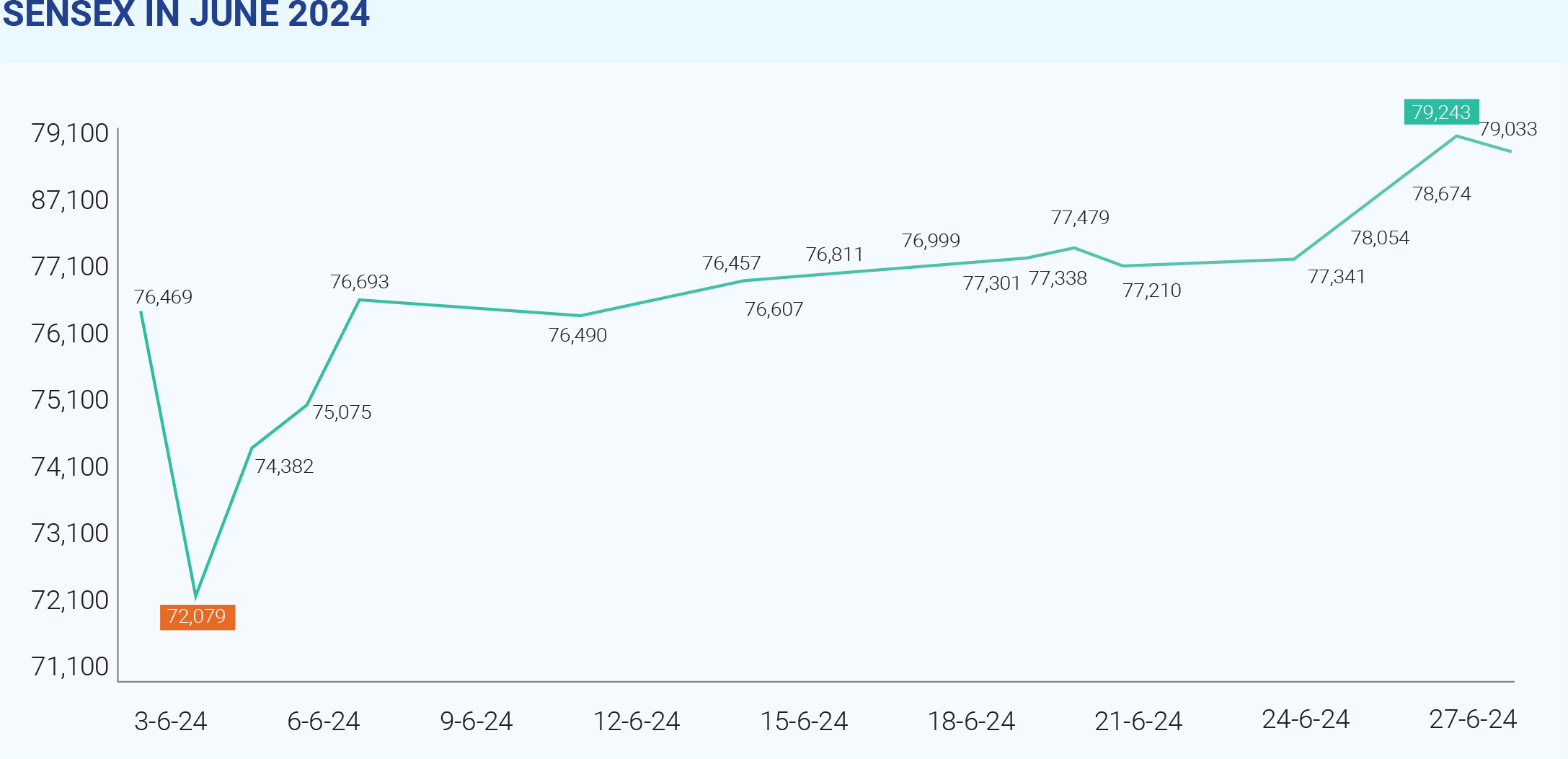The Indian stock market took a wild ride in early June, mirroring the unexpected outcome of the Lok Sabha elections. When results were announced on June 4th, the market plunged – the Nifty 50 index dipped over 5.9% and the Sensex fell 5.7%. This sharp sell-off reflected investor jitters about a hung parliament, with Prime Minister Modi's BJP failing to secure an outright majority and needing to form a coalition government. However, this market panic proved short-lived. Within days, a remarkable recovery unfolded. Over the following nine trading sessions, the Nifty and Sensex surged over 7%, reaching all-time highs. This swift rebound showcased the market's underlying resilience and its faith in India's long-term growth trajectory, even amidst short-term political uncertainties. The initial investor unease stemmed from concerns about the new government's ability to continue Modi's pro-business agenda. With a coalition government, there were worries about potential delays or modifications to economic reforms. However, these anxieties were somewhat quelled by the BJP-led alliance retaining control of key ministries like finance, railways, and commerce. The future direction of the market hinges heavily on the stability and policies of the new coalition. Market experts anticipate the focus to shift towards the government's economic agenda, with hopes pinned on the upcoming Union budget, the positive progress of the monsoon season, and continued foreign investments. Despite the initial volatility, India's long-term market prospects remain bright. Favourable

demographics, steady economic expansion, and the
country's growing global influence paint a compelling
picture for future growth. Notably, sectors like real estate,
private banks, telecom, auto, insurance, and IT
outperformed in June, buoyed by a combination of
positive economic conditions, supportive government
policies, and individual company developments.
June 2024 witnessed a significant shift in the Indian
stock market with Foreign Institutional Investors (FIIs)
turning net buyers. This positive turn comes after two
months of net selling, where FIIs pulled out over ₹34,257
crore (around $4.4 billion) in April and May. The return of
FII interest can be attributed to several key factors like -
formation of a new government, albeit a coalition,
instilled a sense of stability following the Lok Sabha
elections, continuation of good governance and policy
reforms, India's sustained economic growth and positive
GDP projections, impressive corporate earnings reports
and lastly stronger forecasts for India's current account
surplus and its relative outperformance compared to
markets like China and Brazil. Interestingly, FII buying
was concentrated in specific sectors during the first half
of June. Real estate, telecom, and financials saw net
inflows, while IT, metals, and oil & gas experienced net
selling. This suggests a strategic shift by FIIs, moving
funds towards sectors they perceive to offer better
opportunities in the Indian market.
The Indian rupee defied expectations in June 2024,
proving more resilient than most Asian currencies. This
strength stemmed from a confluence of positive factors.
The inclusion of Indian bonds in the prestigious
JPMorgan emerging market bond index triggered billions
of dollars to flow into the country. This translated to over
$8.1 billion in FII inflows into the debt market, bolstering
the rupee. For the first time in ten quarters, India's current
account balance tipped into surplus in Q4 FY2024. This
shift, fueled by a rise in service exports and private
transfer receipts, further strengthened the rupee's
position. The Reserve Bank of India's measured
interventions in the foreign exchange market played a
crucial role. By strategically buying and selling dollars,
the RBI prevented the rupee from appreciating too
quickly while still providing support. Market expectations
for aggressive interest rate cuts by the US Federal
Reserve softened in June. This shift, with fewer
anticipated hikes in the dollar, eased pressure on other
currencies, including the rupee. Overall, June 2024
painted a bright picture for the Indian rupee. Strong
fundamentals, a surge in foreign investment, and a
supportive central bank all contributed to its impressive
performance.
June 2024 presented a mixed picture for oil prices. While
the first half of the year saw a significant increase, June
itself offered a more volatile story. The continual trend
that began in the first half, WTI crude oil futures climbed
roughly 6% in June, marking a total rise of over 13% for
the year so far. Brent crude, the global benchmark, also
witnessed a gain of 1.88% in June. OPEC+'s decision to
gradually increase oil production later in the year,
coupled with continued low demand, particularly in
developed economies, put downward pressure on prices.
Additionally, rising global oil inventories added to the
bearish sentiment. A significant drawdown in U.S. crude
inventories in June countered the downward trend,
leading to a price increase of nearly 3% for the month.
This upward momentum is expected to continue in the
near future before potentially moderating later in the
year. On the domestic front, crude oil prices in India
mimicked the global trend, rising throughout June,
however stayed below the peak levels reached in March
2024. Overall, June was a month of conflicting forces in
the oil market. While global factors like OPEC+ plans and
sluggish demand threatened to dampen prices, a
surprise drawdown in U.S. inventories provided a
temporary boost. The near future is likely to see a
continuation of this tug-of-war between supply and
demand.
Gold prices in India exhibited relative stability throughout
June 2024. There was a price increase of ₹700 for 10
grams of 22-carat gold and ₹760 for 10 grams of 24-carat
gold on June 4th, 2024. This resulted in prices reaching
₹65,718 for 22-carat and ₹71,744 for 24-carat gold.
Favourable global economic conditions, balanced
demand and supply, stable interest rates and inflation
and absence of major seasonal factors are the several
factors which contributed towards the current trend. The
future trajectory of gold prices depends widely on
interest rates in both India and the US and the progress of
the monsoon and upcoming festivals. In essence, June
2024 saw gold prices in India remain largely steady, with
a minor increase on June 4th.
Despite a month marked by both record highs and lows,
the Indian market managed to find stability towards the
end of June. While some sectors thrived in the wake of
the election results, others remain undervalued. While
concerns linger regarding political uncertainty and
potential policy shifts, positive economic data and strong
corporate performance are offering investors a
temporary reprieve. However, July demands a watchful
eye. The upcoming Budget 2024 and the implementation
of new regulations from July 1st, aimed at strengthening
market governance, introduce fresh elements of
uncertainty.

